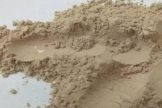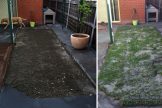
There are a couple of significantly good things about clay soils: the tiny particles which are the building blocks of the clay soil are extremely good at holding onto both water particles and onto nutrients (high cation exchange capacity). This greatly increases the water holding capacity of your soil as well as the ability of the soil to retain nutrients, so they don’t just wash through the soil profile and become lost, leaving the soil hungry again. Soils with no clay (sandy or shale soils) can be very difficult to manage in the long term, becoming easily hydrophobic and struggling to retain moisture and nutrients.
When confronted with a hard clay soil it is tempting to just throw your hands up in despair and import soil. However, it is in your own interests to try and improve what you have, as imported soil often has no clay component at all and requires lots of attention over the years also to improve it in the long run. Clay soils obviously have their problems, but they can be addressed.

The lack of large pore spaces in clay soil restricts water and air movement, resulting in easily waterlogged and anaerobic soils. The only practical way to improve this is the routine addition of plenty of organic matter (can be compost or manure) and fostering the activity of earthworms and soil micro-organisms. These decompose the organic matter and the tiny soil particles are bound with the organic material into clumps resulting in increased pore spaces. Spread organic material 3-10cm thick, and dig in to a depth of around 20cm. Do not over work the soil. Green manure crops are excellent – grown, then turned into the soil when 1/3 to ½ grown, green and lush. Dig in once a year in spring or autumn.
A single large application will not do the trick. It is essential that this is repeated over a number of years. After 2-3 years improvements will be seen and the rate of improvement will rapidly increase as the organic matter increases and earthworms and micro-organisms become more active. Eventually you will get that rich dark fruitcake soil you are after.
If your clay soil is a sodic soil (common around the Bulleen area) then adding gypsum in conjunction with the organic matter will help. You can do a simple dispersion test to see if your clay soil is sodic, roll the clay into a small ball/pellet and put into a glass or into a bowl, cover with distilled water (must be distilled – you can buy it in the supermarket, people use it in their irons). Leave for 24 hours and then see how much it has dispersed/spread out, as per the picture above. The more dispersed the clay pellet, the more sodic the soil.
Avoid compacting clay soils – especially when wet, watch foot traffic, use heavy mulch on paths to avoid compaction.
Avoid excessive cultivation, use just enough to incorporate organic materials and fertilizer. Cultivate when moist but not wet (and not dry).





